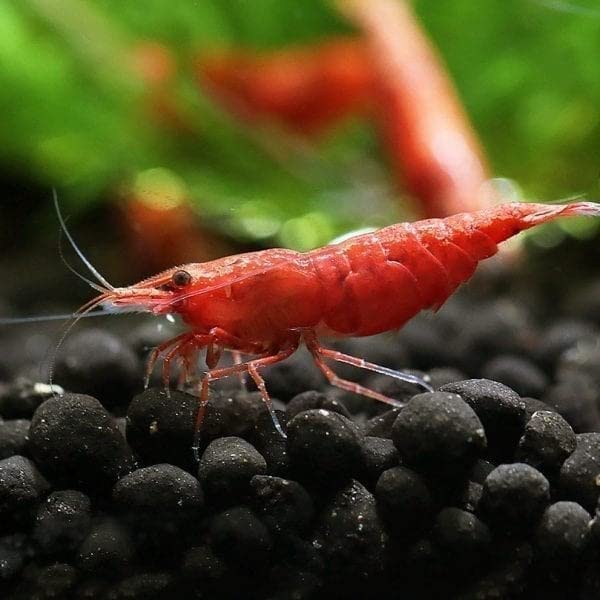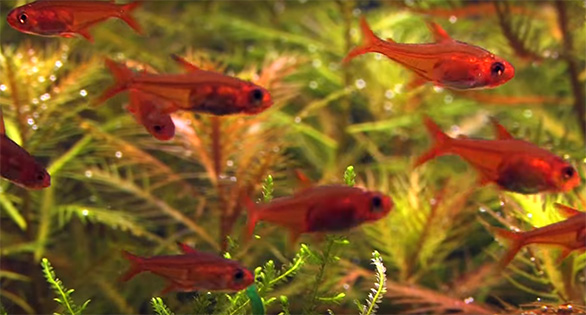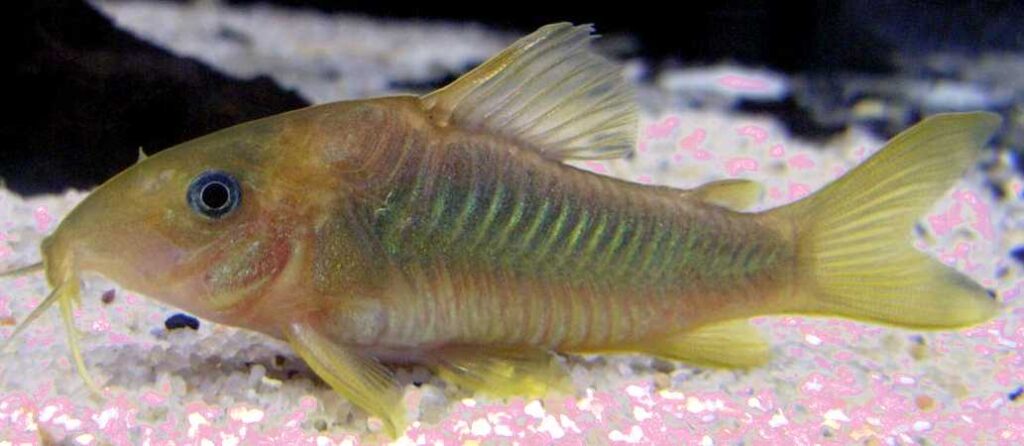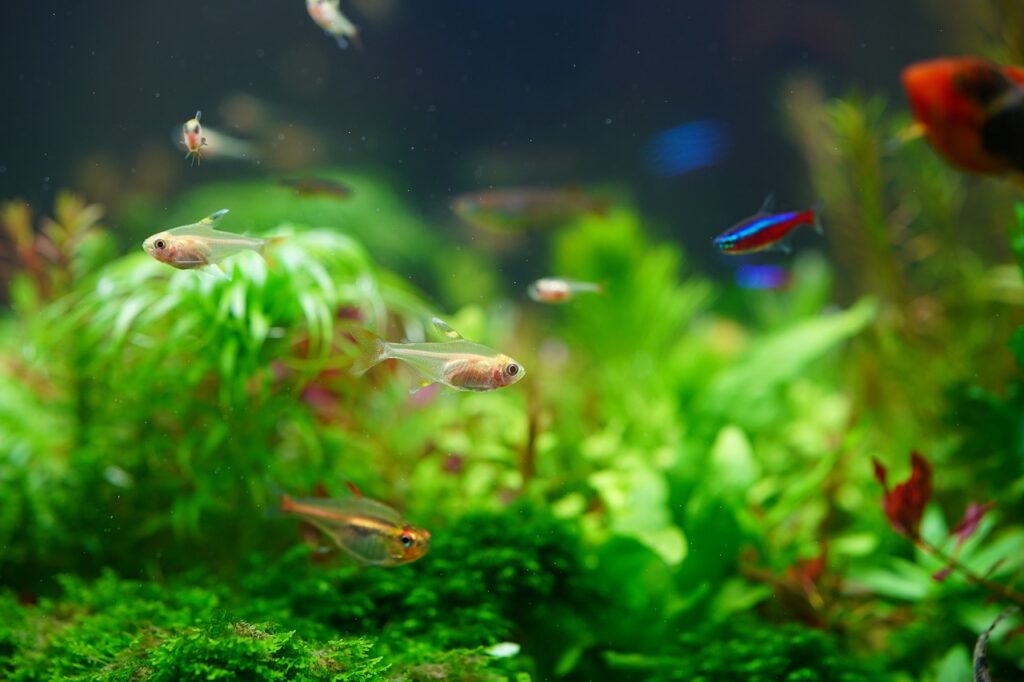When selecting fish for a 55-gallon tank, it is important to choose species that are compatible with each other, have the appropriate temperament and behavior, and are suitable for the water temperature of the tank. It is also important to make sure that the size of the fish does not exceed the size of the tank. In this guide to the best community fish for a 55 gallon tank we will look what to look for and what to avoid when setting up a 55 gallon community tank.
Some good choices for community fish in a 55-gallon tank include peaceful species such as Rainbows (Tequila, Dwarf Neon), Corydoras (Julii, Peppered, Bronze), guppies, Siamese Fighting Fish, Gouramis, Dwarf Gouramis, Dwarf Loaches (Zebra, Yo-Yo), Angelfish, and Plecostomus. Schools of Tetras and Danios can also work nicely. Remember to avoid aggressive fish such as Oscars, Jack Dempsey’s, or South American Cichlids, which could easily outcompete other tank mates.
What to consider when picking the 5 best community fish for a 20 gallon tank
A 20 gallon tank is big enough that you can add bigger fish and more fish to the tank, you still want to be careful not to overstock the tank right away before it has a chance to establish the bio load management in it.
1. Size of the fish
The size of the fish can be important when selecting the 5 best community fish for a 20 gallon tank. You want to choose fish that are all similar in size to one another so one species does not bully or consider another species food.
2. Water Chemistry
Different species of fish prefer different water parameters and it is important to find fish that prefer the water the same temperature and the same hardness.
3. Diet and feeding habits
Having fish that have the same diet will make it easier to feed your fish the proper diet. If your fish are carnivores it is important to make sure all the fish are carnivores or at least omnivores. And the same holds true for herbivores.
4. Temperament and compatibility with other fish.
The temperament of each fish species can be different and it is important to find fish that have a similar temperament and chemistry. This will help with the compatibility with each fish and how they interact with each other.
Best community fish for 55 gallon tank.

Due to their popularity among aquarists, the Cherry Barb has been listed as vulnerable on the IUCN Red List. This is due to overharvesting, as well as the dwindling quality and availability of their natural habitats. Therefore, it’s important to practice responsible tank stocking when considering these fish as pets.
If you’re interested in owning Cherry Barbs, here are some tips for making the best decision for you and your tank:
• Start small – Add a group of no more than six to your tank to start with and observe how they interact before adding any more, especially if you’re new to owning this species.
• Water parameters – Make sure that the pH, temperature, and hardness levels are suitable for this species.
• Tank mates – Select other fish that are of similar size and temperament to the Cherry Barbs, making sure to avoid anything that might be aggressive or overly enthusiastic.
• Diet – These fish are omnivorous, so they’ll happily nibble on a range of beginner-friendly flakes and pellets. In conclusion, the Cherry Barb is an ideal fish to own both in terms of looks and care requirements.
As long as you practice smart tank stocking and look after them properly, these fish are sure to bring life and color to your aquarium.
These fish are known to be peaceful and tolerant when it comes to their tankmates. They can easily be combined with a range of other freshwater fish species, regardless of their size. Thus, Cherry Barbs make an excellent addition in a diverse aquarium community.
2. Cherry Shrimp
Cherry shrimp are a popular, eye-catching continue reading aquarium pleco that make a great addition to small tanks. Notr only are they visually appealing with their vivacious hues, but they also help keep tanks clean by devouring algae. Plus, they have minimal care requirements, making them the perfect inhabitants for beginners and experienced aquarists alike.

Their diminutive size makes them an ideal choice for nano and pico tanks, but they can thrive just as easily in larger tanks as long as they have the right environment. Because they only grow to be approximately one inch long, they need a tank that’s at least 5+ -gallons. Even better, try a 20-gallon tank that has plenty of room for them to explore and roam around. Be sure to provide your cherry shrimp with plenty of surface vegetation and hiding places such as driftwood, plastic plants, rocky caves, and plastic flowerpots. This will give them plenty of places to forage for food, rest, and hide from more aggressive tank mates. Adding some dark substrate to the bottom of the tank will create a natural-looking habitat as well as help promote better water quality.
Cherry shrimp also require pristine water conditions if they’re to stay healthy. How to set up a shrimp tank. Ensure that the pH levels remain stable and at the right range, which should be between 6.5 and 8.0, and that the temperature is kept between 68°F and 78°F. Ammonia and nitrites should both be at zero, while nitrate levels should be under 10 ppm. Regularly changing at least 25 percent of the tank’s water will help keep everything clean and safe. Cherry shrimp also need rich algal growth to indulge in. This can be achieved by introducing some live plants to your tank and adding some extra fertilizer to encourage the growth of algae. It’s possible to keep cherry shrimp in small tanks, but it’s important to remember that they still require an ideal habitat and environment in order to stay healthy. With the right setup, however, these tiny invertebrates can be an extremely rewarding addition to your aquarium.
3. Ember Tetras
Adding these red-orange tetras to an aquarium of at least 10 – 20 gallons can give it a lively, vibrant look. You should try and get a school of at least five or six to reduce the chance of the predator picking any of them out. These peaceful fish typically swim around the middle of the tank and consume the same food as the other herbivores, simplifying their care.

The Ember tetra fish is a brightly colored type of fish that is often kept in aquariums. They require a minimum tank size of 10 gallons with a few live aquarium plants. The water should be lightly acidic and around a pH of 6.6, with temperatures ranging between 73 and 84 degrees Fahrenheit. To keep them healthy and happy, the tank should have a darker substrate and plenty of live plants, as the Ember tetra is quite fond of swimming through them.
When purchasing Ember tetras, it’s best to get a group of at least 6, though the recommended group size is 9-10. Tetras should also be kept with other types of tetras, such as the neon tetra, though they should not be kept with fish significantly larger than them. These fish swim mainly in the middle level of the aquarium and prefer to feed on food located there rather than on the bottom of the tank. To avoid any leftovers, it is recommended that Ember tetras are kept with bottom feeding fish such as pygmy corydoras.
Ember tetras are relatively easy to care for and can be fed a variety of food, including flake, frozen, and freeze-dried foods. To really bring out their colors though, it is a good idea to also provide them with live foods such as worms and brine shrimp. If a well-maintained aquarium is provided for them, Ember tetras can potentially live for up to 10 years or more.
4. Harlequin Rasboras
The peaceful, 2-inch Rasbora is ideal for beginner fish keepers. These fish feature an eye-catching orange body with a black triangular patch that adds to its attractive appearance. To ensure a healthy and happy school of Rasboras, it is recommended to buy at least six. These gentle fish get along with other tankmates, including Bettas, and provide great exercise and enrichment for them as they’ll attempt to chase the Rasboras without much success. To learn more about caring for Rasboras, take a look at our full care guide.

The Harlequin Rasbora is a fish with an orange-pink body and a large, triangular black pattern on its back, extending from the midpoint of its dorsal fin towards its caudal peduncle. The tail fin is red on the outer rays and hyaline on the inner part. The pectoral and pelvic fins of the Harlequin Rasbora are found in a common cyprinid pattern, the pectoral fins sitting behind its operculum, and the pelvic fins forward of the dorsal fin.
A mature Harlequin Rasbora measures up to 2 inches (5 cm) in length. Males tend to have a slightly bigger black patch and a more rounded marking at the anal fin while ripe females have a fuller body outline.
Species of fish similar to the Harlequin Rasbora are Trigonostigma espei and Trigonostigma hengeli, which were once considered subspecies. These fish have a more slender body shape, and the black marking is replaced by a horizontal strip tapering to the caudal peduncle, thickened and extended below the dorsal fin. This marking pattern is also known as a lamb chop, due to its resemblance to the cut of meat.
4. Kuhli Loach
Kuhli loaches make excellent tankmates for your betta fish! These eel-shaped beauties are peaceful, and do a great job of cleaning up leftover food in the aquarium. Although they can be a bit shy, they add a ton of personality to the tank. A must-have for any aquarist looking to add an extra bit of life and color to the aquarium!

The Kuhli Loach (Pangio kuhlii), also known as the Coolie Loach or Leopard Loach, is an Old World fish from the Cobitidae family. Originating in Southeast Asian freshwater streams, such as Malaysia, Thailand, and Borneo, the Kuhli Loach was first classified in 1846 and was used historically as a source of food in Indonesia.
3. Otocinclus
Otocinclus catfish, also known as “otos,” are a species of small algae eating fish that are kept in aquarium to clean up and control algae. They are known for their peaceful and hardy nature, which makes them an ideal addition to any community tank with bettas. Otocinclus catfish have a slender, brown or black body and are known for their ability to clean algae from aquarium plants and surfaces.

In terms of care, otocinclus catfish are easy to take care of and is well-adapted to captive life. They prefer a well-cycled tank with proper filtration and water quality and some live plants. Otocinclus catfish require water temperatures between 72-82°F and a slightly acidic to neutral pH between 6.0-7.5. They are strictly herbivores and require a diet consisting mainly of algae wafers or blanched vegetables.
Otocinclus catfish can play an important role in maintaining the health of an aquarium by keeping surfaces of the aquarium and plants free of algae.
2. Cory Catfish
Cory catfish, also known as Corydoras, are a popular species of tropical fish that do very good in community aquariums. These small, bottom-dwelling fish are known for their gentle and peaceful nature, and for keeping the bottom of tanks clean, making them an ideal addition to a community tank. Cory catfish have a distinctive, armored body with hard spikes and come in a variety of colors, that can include albino, spotted, green, and black.

Taking care of Cory catfish is easy because, Cory catfish are hardy and easy to feed, making them a good choice for both beginner and experienced aquarists. They are well-adapted to community life and thrive in a well-cycled tank with proper filtration and water quality. Cory catfish prefer water temperatures between 72-78°F with a slightly acidic to neutral pH between 6.0-7.5. They are omnivores and will feed on a variety of foods including flakes, pellets, and small live or frozen foods.
Cory catfish play an important role in maintaining the health of an aquarium by scavenging for food and cleaning up waste. They are also active and social fish that will add both interest and liveliness to a community tank. With their peaceful nature, hardiness, and ease of care, Cory catfish are an excellent choice for a 20-gallon community tank and make an ideal addition to any community of similarly sized fish.
5. Cardinal Tetra
The cardinal tetra is my go to pick for a community fish that prefers to hang out in the middle of the tank, they prefer to stay in schools so it is always best to make sure you have at least four to six in your tank.

The cardinal tetra is a popular and pretty fish often kept in community fish tanks, this small fish is known for its bright blue and red stripes along its body, making it a beautiful addition to a clean tank with a dark background. Cardinal tetras are peaceful and are best kept in a tank with other small, friendly fish.
Taking care of cardinal tetras is not difficult, making them a good option for new fish tank owners while they are a tough fish that can handle life in a tank and will do well with proper filtration and water quality. Neon tetras like water that is between 72-82°F and have a pH between 6.0-7.0. They eat a mix of things, including flakes, pellets, and small live or frozen foods.
When kept in the right environment, cardinal tetras are lively and social, adding a pop of color to any tank. With their peaceful nature and easy care, neon tetras are a great choice for a 20-gallon tank and will fit in well with other similarly sized fish.
8. Glass Catfish

Glass catfish are a great addition to any freshwater tank due to their low-maintenance nature and active behavior. With their striking translucent bodies, they make for a unique and eye-catching addition. Adding other tank mates to your community tank is easy and hassle-free as long as you keep away from large and aggressive species. Glass catfish will thrive in a well-maintained aquarium, keeping your tank lively and vibrant.
9. Guppies
Guppy fish are an incredibly popular freshwater fish in the aquarium scene, sporting gorgeous tailfins filled with color! Low-maintenance and beginner friendly, these fish have a minnow-like profile with a pointed snout and upturned mouth. With luck and genetics, the guppy fish lifespan can be between two and five years, with adults reaching up to two inches in length. Appropriate tank size would be at least a five-gallon tank, but preferably a 10-gallon tank or larger. The best environment for guppies would be one with a water temperature of 64°F to 84°F, pH level of 7.5 to 8.0, and water hardness of 8 to 12. When it comes to decorations, guppies aren’t picky and prefer natural items whenever possible.

Guppy fish are an ideal choice for those looking to start their own fish-keeping tank, as they are well-suited to peaceful multi-species tanks. These small fish possess vibrant fan-like tails in a variety of colors, making them an aesthetically pleasing addition to any aquarium. Guppies tend to swim towards the top of the water and do best in tanks with plenty of vegetation. Furthermore, breeding is easy, since guppies are livebearers and the fry are born fully-formed.











